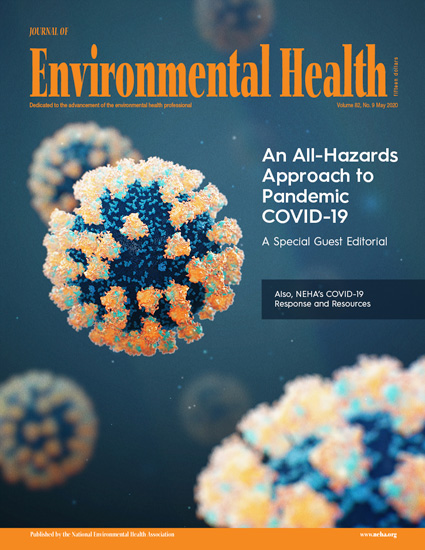Olfactory and cognitive decrements in 1991 Gulf War veterans with gulf war illness/chronic multisymptom illness
IF 5.3
2区 环境科学与生态学
Q1 ENVIRONMENTAL SCIENCES
引用次数: 0
Abstract
Gulf War illness (GWI)/Chronic Multisymptom Illness (CMI) is a disorder related to military service in the 1991 Gulf War (GW). Prominent symptoms of GWI/CMI include fatigue, pain, and cognitive dysfunction. Although anosmia is not a typical GWI/CMI symptom, anecdotally some GW veterans have reported losing their sense smell shortly after the war. Because olfactory deficit is a prodromal symptom of neurodegenerative diseases like Parkinson’s and Alzheimer’s disease, and because we previously reported suggestive evidence that deployed GW veterans may be at increased risk for Mild Cognitive Impairment (MCI) and dementia, the current study examined the relationship between olfactory and cognitive function in deployed GW veterans. Eighty deployed GW veterans (mean age: 59.9 ±7.0; 4 female) were tested remotely with the University of Pennsylvania Smell Identification Test (UPSIT) and the Montreal Cognitive Assessment (MoCA). Veterans also completed self-report questionnaires about their health and deployment-related exposures and experiences. UPSIT and MoCA data from healthy control (HC) participants from the Parkinson’s Progression Markers Initiative (PPMI) study were downloaded for comparison. GW veterans had a mean UPSIT score of 27.8 ± 6.3 (range 9–37) and a mean MoCA score of 25.3 ± 2.8 (range 19–30). According to age- and sex-specific normative data, 31% of GW veterans (vs. 8% PPMI HCs) had UPSIT scores below the 10th percentile. Nearly half (45%) of GW veterans (vs. 8% PPMI HCs) had MoCA scores below the cut-off for identifying MCI. Among GW veterans, but not PPMI HCs, there was a positive correlation between UPSIT and MoCA scores (Spearman’s ρ = 0.39, p < 0.001). There were no significant differences in UPSIT or MoCA scores between GW veterans with and without history of COVID or between those with and without Kansas GWI exclusionary conditions. We found evidence of olfactory and cognitive deficits and a significant correlation between UPSIT and MoCA scores in a cohort of 80 deployed GW veterans, 99% of whom had CMI. Because impaired olfactory function has been associated with increased risk for MCI and dementia, it may be prudent to screen aging, deployed GW veterans with smell identification tests so that hypo- and anosmic veterans can be followed longitudinally and offered targeted neuroprotective therapies as they become available.患有海湾战争疾病/慢性多症状疾病的 1991 年海湾战争退伍军人的嗅觉和认知能力下降
海湾战争病(GWI)/慢性多症状疾病(CMI)是一种与 1991 年海湾战争(GW)服兵役有关的疾病。海湾战争病/慢性多症状疾病的主要症状包括疲劳、疼痛和认知功能障碍。虽然嗅觉缺失不是 GWI/CMI 的典型症状,但据传闻,一些 GW 退伍军人在战后不久就失去了嗅觉。由于嗅觉缺失是帕金森病和阿尔茨海默病等神经退行性疾病的前驱症状,而且我们之前也报告过有提示性证据表明,被部署的全球战略退伍军人患轻度认知功能障碍(MCI)和痴呆症的风险可能会增加,因此本研究对被部署的全球战略退伍军人的嗅觉和认知功能之间的关系进行了研究。80 名全球战略部队退伍军人(平均年龄:59.9 ±7.0; 4 名女性)接受了宾夕法尼亚大学嗅觉识别测试 (UPSIT) 和蒙特利尔认知评估 (MoCA) 的远程测试。退伍军人还填写了有关其健康状况以及与部署相关的接触和经历的自我报告问卷。此外,还下载了帕金森病进展标志物倡议(PPMI)研究中健康对照组(HC)参与者的 UPSIT 和 MoCA 数据进行比较。GW 退伍军人的 UPSIT 平均得分为 27.8 ± 6.3(范围为 9-37),MoCA 平均得分为 25.3 ± 2.8(范围为 19-30)。根据年龄和性别特异性常模数据,31%的GW退伍军人(与8%的PPMI HCs相比)的UPSIT得分低于第10百分位数。近一半(45%)的GW退伍军人(与8%的PPMI高危人群相比)的MoCA得分低于识别MCI的临界值。在 GW 退伍军人中,UPSIT 和 MoCA 分数之间呈正相关(Spearman's ρ = 0.39,P < 0.001),而 PPMI HCs 则不然。有 COVID 病史和无 COVID 病史的 GW 退伍军人之间,以及有堪萨斯 GWI 排斥条件和无堪萨斯 GWI 排斥条件的 GW 退伍军人之间,在 UPSIT 或 MoCA 分数上没有明显差异。我们发现了嗅觉和认知功能障碍的证据,并发现在 80 名部署的 GW 退伍军人队列中,UPSIT 和 MoCA 分数之间存在显著相关性,其中 99% 的人患有 CMI。由于嗅觉功能受损与 MCI 和痴呆症的风险增加有关,因此通过嗅觉识别测试来筛查老龄化、已部署的 GW 退伍军人可能是明智之举,这样就可以对低嗅觉和无嗅觉的退伍军人进行纵向跟踪,并在有针对性的神经保护疗法时向他们提供这些疗法。
本文章由计算机程序翻译,如有差异,请以英文原文为准。
求助全文
约1分钟内获得全文
求助全文
来源期刊

Environmental Health
环境科学-公共卫生、环境卫生与职业卫生
CiteScore
10.10
自引率
1.70%
发文量
115
审稿时长
3.0 months
期刊介绍:
Environmental Health publishes manuscripts on all aspects of environmental and occupational medicine and related studies in toxicology and epidemiology.
Environmental Health is aimed at scientists and practitioners in all areas of environmental science where human health and well-being are involved, either directly or indirectly. Environmental Health is a public health journal serving the public health community and scientists working on matters of public health interest and importance pertaining to the environment.
 求助内容:
求助内容: 应助结果提醒方式:
应助结果提醒方式:


